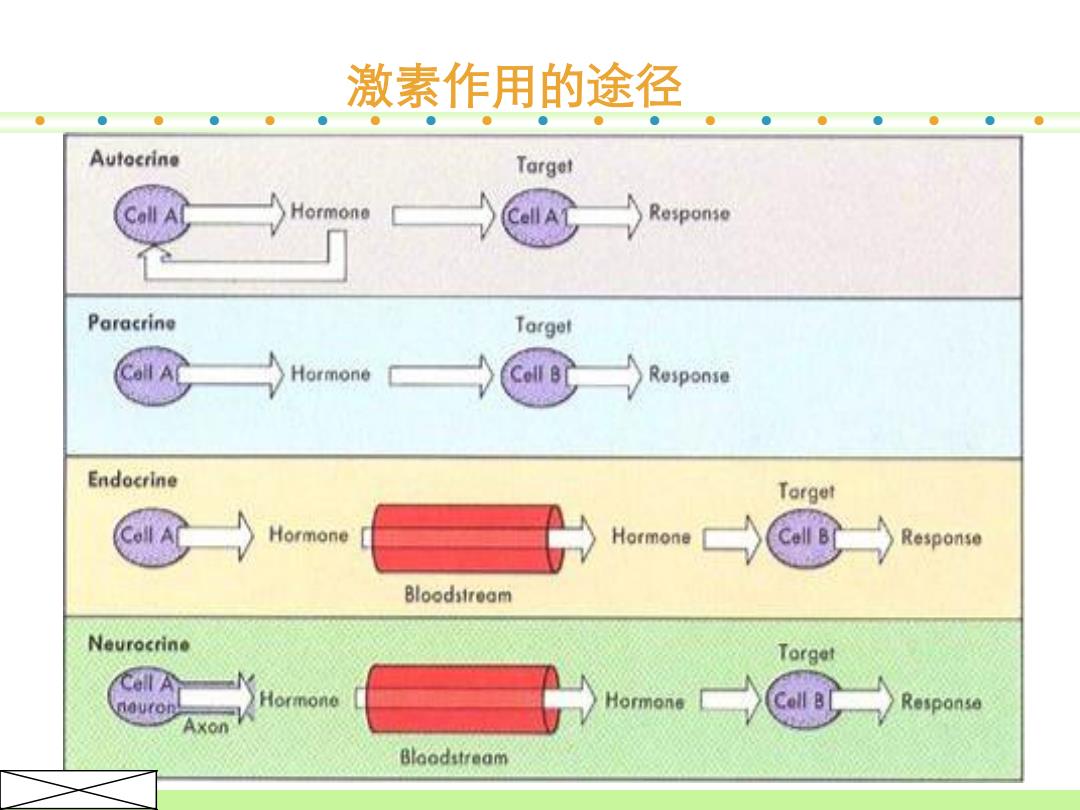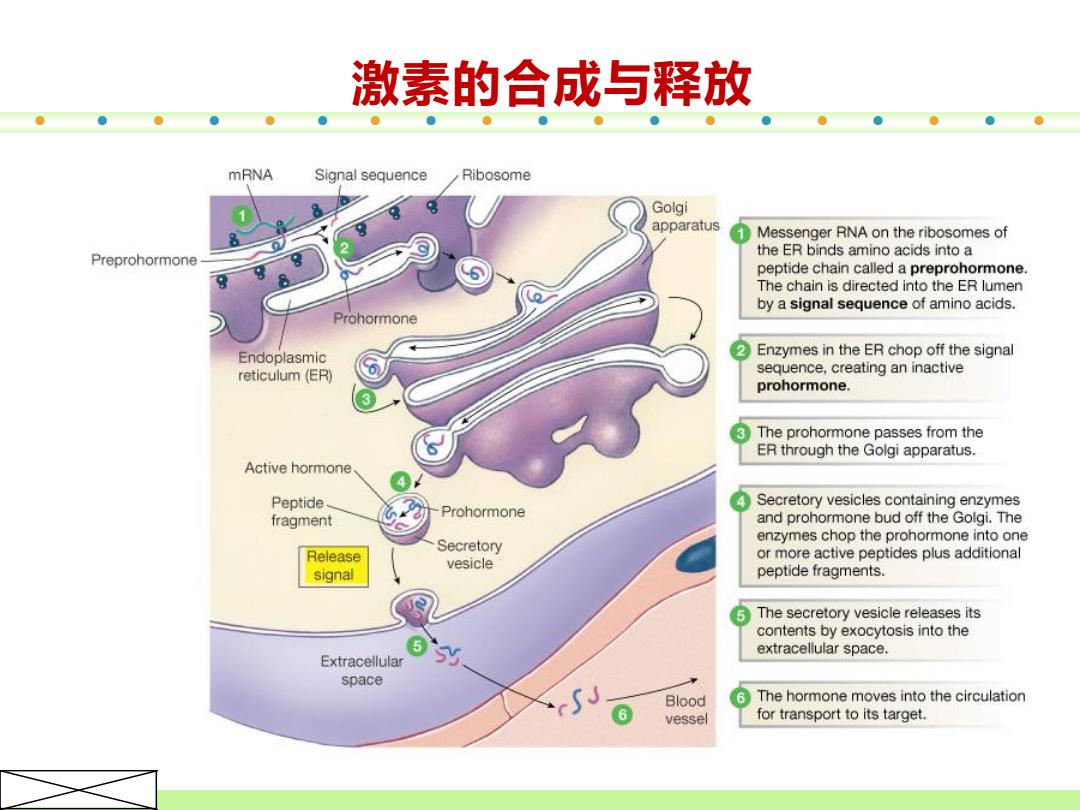
第十章内分泌 概述 下丘脑与垂体 3 用状腺 4 调节钙磷代谢的激素 5 胰岛 6 肾上腺 其它内分泌器官
Contents 1 概 述 2 下丘脑与垂体 3 甲状腺 4 调节钙磷代谢的激素 5 胰 岛 6 肾上腺 7 其它内分泌器官 第十章 内分泌

内分泌(录像) Figure 11.1.(a)The anatomy of some of the endocrine glands. (b)An islet of Langerhans within the pancreas. 内分泌系统 endocrine Pineal body 内分泌腺 Hypothalamus Thyroid gland Parethyroid glands 内分泌细胞 (behind thyroid gland) 激素(hormone):由内分 Adrenal 泌腺或散在的内分泌细 Pancreas- 胞分泌的高效能生物活 Ovary 性物质
内分泌系统 endocrine 内分泌(录像) 内分泌腺 内分泌细胞 激 素 (hormone):由内分 泌腺或散在的内分泌细 胞分泌的高效能生物活 性物质

激素作用的途径 ● ● Autocrine Target Hormone Response Paracrine Target A Hormone Response Endocrine Target Hormone Hormone Cell B Response Bloodstream Neurocrine Torget ℃eA Homone→@0 Response Axon Blaodstream
● ● ● ● ● ● ● ● ● ● ● ● ● ● ● ● ● ● ● 激素作用的途径

激素的分类 1)含氨激素 A.肽类和蛋白质类Proteins and Polypeptides B.胺类激素Amine hormone:N,NE,T 2)类固醇(甾体)激素Steroids 皮质醇、醛固酮、雌激素、孕激素、雄激素 胆固醇衍生物:1,25-二羟维生素D3
1)含氮激素 A.肽类和蛋白质类 Proteins and Polypeptides B.胺类激素 Amine hormone:N, NE, T 2)类固醇(甾体)激素 Steroids 皮质醇、醛固酮、雌激素、孕激素、雄激素 胆固醇衍生物:1,25-二羟维生素D3。 激素的分类

激素的合成与释放 mRNA Signal sequence Ribosome Golgi apparatus Messenger RNA on the ribosomes of the ER binds amino acids into a Preprohormone peptide chain called a preprohormone. The chain is directed into the ER lumen by a signal sequence of amino acids. Prohormone Endoplasmic 2Enzymes in the ER chop off the signal reticulum(ER) sequence,creating an inactive prohormone. The prohormone passes from the ER through the Golgi apparatus. Active hormone Peptide Secretory vesicles containing enzymes Prohormone fragment and prohormone bud off the Golgi.The enzymes chop the prohormone into one Release Secretory or more active peptides plus additional vesicle signal peptide fragments. The secretory vesicle releases its contents by exocytosis into the y extracellular space. Extracellular space Blood 6 The hormone moves into the circulation 6 vessel for transport to its target
● ● ● ● ● ● ● ● ● ● ● ● ● ● ● ● ● ● ● 激素的合成与释放

激素作用的机制 Peptide hormones(H)cannot enter their target cells and must combine with membrane receptors(R)that initiate signal transduction processes. (1)蛋白质或多肽激素 second messenger R mechanisms Opens ion channel Second messenger system phosphorylate KEY Proteins TK =Tyrosine kinase AE=Amplifier enzyme Cellular G=G protein response
激素作用的机制 (1)蛋白质或多肽激素 second messenger mechanisms

cAMP-PKA pathway Hormone (first messenger) Bind to G protein-linked receptor Gprotein activated Adenylyl cyclase(AC)activated ATP cAMP(second messenger) Activate cAMP-dependent protein kinase A Cellular response
Hormone (first messenger) Adenylyl cyclase(AC) activated ATP cAMP(second messenger) Cellular response Activate cAMP-dependent protein kinase A Bind to G protein-linked receptor Gprotein activated cAMP-PKA pathway

类固醇激素的作用机制 基因表达学说 modulation of gene expression Blood Steroid Cell surface receptor Most hydrophobic steroids are bound vessel hormone to plasma protein carriers.Only unbound hormones can diffuse into the target cell. 6 Rapid responses 2 Steroid hormone receptors are in the Protein cytoplasm or nucleus. carrier Nucleus Cytoplasmic 3 The receptor-hormone complex binds receptor- Nuclear to DNA and activates or represses one receptor or more genes. 4 Activated genes create new mRNA Interstitial Endoplasmic that moves back to the cytoplasm. fluid reticulum Cell membrane 5 Translation produces new proteins Transcription for cell processes. produces mRNA 6 Some steroid hormones also bind to membrane receptors that use second Translation New proteins messenger systems to create rapid cellular responses
基因表达学说 modulation of gene expression 类固醇激素的作用机制

激素分泌的调节 Stimulus Hypothalamus 神经调节 (C;) nerve regulation Trophic hormone (H,) Anterior pituitary 激素的反馈调节 (C2) Hormonal regulation Trophic hormone (H2) Long-loop negative feedback feedback control Endocrine gland (C) KEY Hormone(Ha) Stimulus Target tissue ○Integrating center Efferent path ☐Effector Response ●Systemic response
神经调节 nerve regulation 激素的反馈调节 Hormonal regulation feedback control 激素分泌的调节

下丘脑分泌的激素 表112下丘脑调节肽的化学性质与主要作用 种类 英文缩写 化学性质 主要作用 促甲状腺激素释放激素 TRH 三肽 促进TSH释放,也能刺激PRL释放 促性腺激素释放激素 GnRH 十肽 促进LH与FSH释放(以LH为主) 生长素释放抑制激素 (HRIH 十四肽 抑制GH释放,对LH、SH、TSH、 (生长抑素) PRL及ACTH的分泌也有抑制作用 生长素释放激素 GHRH 四十四肽 促进GH释放 促肾上腺皮质激素释放激素 CRH 四十一肽 促进ACIH释放 促黑(素细胞)激素释放因子 MRF 肽 促进MSH释放 促黑(素细胞)激煮释 MIF 肽 抑制MSH释放 放抑制因子 催乳素释放因子 PRF 肽 促进PRL释放 催乳素释放抑制因子 PIF 多巴胺(?) 抑制PRL释放
● ● ● ● ● ● ● ● ● ● ● ● ● ● ● ● ● ● ● 下丘脑分泌的激素